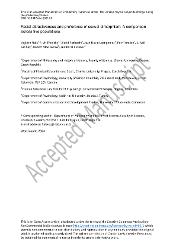Facial attractiveness and preference of sexual dimorphism: A comparison across five populations
| dc.contributor.author | Vojtech, Fiala | |
| dc.contributor.author | Vít, Trebicky | |
| dc.contributor.author | Farid, Pazhoohi | |
| dc.contributor.author | Juan David, Leongómez | |
| dc.contributor.author | Petr, Turecek | |
| dc.contributor.author | Robert Mbe, Akoko | |
| dc.contributor.author | Karel, Kleisner | |
| dc.contributor.author | S. Adil, Sarıbay | |
| dc.date.accessioned | 2021-07-17T16:28:27Z | |
| dc.date.available | 2021-07-17T16:28:27Z | |
| dc.date.issued | 2021 | |
| dc.identifier.issn | 2513-843X | en_US |
| dc.identifier.uri | https://hdl.handle.net/20.500.12469/4066 | |
| dc.description.abstract | Despite intensive research, evolutionary psychology has not yet reached a consensus regarding the association between sexual dimorphism and attractiveness. This study examines associations between perceived and morphological facial sexual dimorphism and perceived attractiveness in samples from five distant countries (Cameroon, Colombia, Czechia, Iran, and Turkey). We also examined possible moderating effects of skin lightness, averageness, age, body mass, and facial width. Our results suggest that in all samples, women’s perceived femininity was positively related to their perceived attractiveness. Women found perceived masculinity in men attractive only in Czechia and Colombia, two distant populations. The association between perceived sexual dimorphism and attractiveness is thus potentially universal only for women. Across populations, morphological sexual dimorphism and averageness are not universally associated with either perceived facial sexual dimorphism or attractiveness. With our exploratory approach, results highlight the need for control of which measure of sexual dimorphism is used (perceived or measured) because they affect perceived attractiveness differently. Morphological averageness and sexual dimorphism are not good predictors of perceived attractiveness. It is noted that future studies should use more population samples to allow for identification of specific effects of local environmental and socioeconomic conditions on preferred traits in unmanipulated local facial stimuli. | en_US |
| dc.language.iso | eng | en_US |
| dc.publisher | Cambridge University Press | en_US |
| dc.rights | info:eu-repo/semantics/openAccess | en_US |
| dc.subject | Geometric Morphometrics | en_US |
| dc.subject | Human Face | en_US |
| dc.subject | Sexual Dimorphism | en_US |
| dc.subject | Skin Luminance | en_US |
| dc.title | Facial attractiveness and preference of sexual dimorphism: A comparison across five populations | en_US |
| dc.type | article | en_US |
| dc.relation.journal | Evolutionary Human Sciences | en_US |
| dc.identifier.wos | WOS:000775496800001 | en_US |
| dc.identifier.doi | 10.1017/ehs.2021.33 | en_US |
| dc.identifier.scopus | 2-s2.0-85109389754 | en_US |
| dc.institutionauthor | Sarıbay, S. Adil | en_US |
| dc.relation.publicationcategory | Makale - Uluslararası Hakemli Dergi - Kurum Öğretim Elemanı | en_US |
| dc.identifier.pmid | 37588529 | en_US |
Files in this item
This item appears in the following Collection(s)
-
Scopus İndeksli Yayınlar Koleksiyonu [2197]
Scopus Indexed Publications Collection -
WoS İndeksli Yayınlar Koleksiyonu [2113]
WoS Indexed Publications Collection
















